Lisinopril

"Discount lisinopril 2.5 mg with amex, blood pressure medication hydro".
M. Olivier, M.A., Ph.D.
Program Director, University of Texas Medical Branch School of Medicine
In addition to iron blood pressure chart readings for ages cheap 5 mg lisinopril fast delivery, the nutritional anemia formulation includes ascorbic acid to enhance iron absorption hypertension home remedies discount 2.5 mg lisinopril with visa, folic acid to prevent megaloblastic anemia blood pressure newborn purchase lisinopril 2.5mg line, and zinc and vitamin A to enhance immune status lipo 6 arrhythmia order lisinopril 2.5mg with amex. The level of nutrients used in the formulations is based on bioavailability and doseresponse studies using Sprinkles as well as the Micronutrient Sprinkles to control anemia 279 Table 17. There are also cognitive benefits associated with the prevention of iron deficiency anemia, which, when translated into academic achievement and ultimate adult employment are estimated to be $37 gained for each $1 spent. Heinz Company of Pittsburgh expressed an interest in the Sprinkles program as a component of their corporate social responsibility program. Heinz Company has provided support and expertise in evaluation of consumer needs and a supply of Sprinkles for research, while the H. Through a formal process of technology transfer, local country-specific Sprinkles production has been encouraged. Currently approved independent manufacturers are supporting Sprinkles production in Guyana, Pakistan, Bangladesh, Indonesia, India, and Canada. While taking Sprinkles from small-scale research projects to larger-scale programs, we quickly realized that our research group did not have the necessary funding, experience, or personnel needed to influence health policy, develop a social marketing strategy, or maintain a distribution network at a countrywide level. We have thus partnered with organizations that specialize in each of these areas to help achieve our goal of sustainable distribution. Tondeur lactating women are underway in Bangladesh, Kyrgyzstan, Mexico, and Canada. It is hoped that Sprinkles for pregnant and lactating women will follow the same path as Sprinkles for children by providing an evidence-based, cost-effective approach to treat and prevent anemia, a major cause of morbidity and mortality in women in developing countries. It has been determined that the use of Sprinkles does not appreciably change the taste or color of the food to which it is added; it has been shown that anemia rates decrease with the use of Sprinkles; and it has been documented that the acceptability of Sprinkles among caregivers who use Sprinkles in their homes is high. Finally, through various partnerships, successful models to scale up the intervention for countrywide use have been developed. The challenge for the future is to advocate for the adoption of Sprinkles in nutrition policies of underdeveloped countries to allow the distribution of Sprinkles to vulnerable populations. Encapsulation may also reduce gastrointestinal discomfort and interaction of iron with other nutrients. No special measuring utensils or handling is required and they can be given with any meal during the day. Without this support, we would not have been able to accomplish our numerous research goals in support of improving the nutrition of vulnerable populations worldwide. Grateful thanks are expressed to our research affiliates and program partners around the world without whom none of the research projects on Sprinkles would have been possible. A review of studies on the effect of iron deficiency on cognitive development in children. Experiences and challenges in industrialized countries: control of iron deficiency in industrialized countries. Treatment of anemia with microencapsulated ferrous fumarate plus ascorbic acid supplied as sprinkles to complementary (weaning) foods. Home-fortification with iron and zinc sprinkles or iron sprinkles alone successfully treats anemia in infants and young children. Micronutrients (including zinc) reduce diarrhoea in children: the Pakistan Sprinkles Diarrhoea Study. Effect of daily versus once weekly home fortification with sprinkles on haematological and iron status among young children in rural Bangladesh. Determination of iron absorption from intrinsically labeled microencapsulated ferrous fumarate (sprinkles) in infants with different iron and hematologic status by using a dual-stable-isotope method. Demonstrating zinc and iron bioavailability from intrinsically labeled microencapsulated ferrous fumarate and zinc gluconate Sprinkles in young children. Multi-micronutrient Sprinkles including a low dose of iron provided as microencapsulated ferrous fumarate improves haematologic indices in anaemic children: a randomized clinical trial. Doubleblind, placebo-controlled trial comparing effects of supplementation with two different combinations of micronutrients delivered as sprinkles on growth, anemia, and iron deficiency in cambodian infants. Randomized comparison of 3 types of micronutrient supplements in Ghanaian infants. Proceedings of the International Nutritional Anemia Consultative Group Symposium; November 18, 2004; Lima, Peru. Home fortification with Sprinkles to reduce childhood anemia: lessons learned in North West Frontier Province, Pakistan.
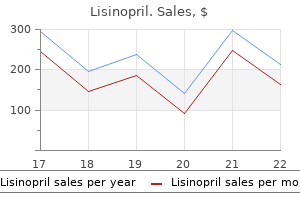
These analyses are sometimes useful in identifying and quantifying the actual pesticide to which workers have been exposed blood pressure kidney damage cheap lisinopril 10 mg with amex. Urinary alkyl phosphate and phenol analyses can demonstrate organophosphate absorption at lower dosages than those required to depress cholinesterase activities and at much lower dosages than those required to produce symptoms and signs blood pressure position order lisinopril 2.5 mg line. In general arrhythmia quality services order lisinopril 5 mg without a prescription, organophosphates do not remain unhydrolyzed in the blood more than a few minutes or hours arteria bulbi urethrae purchase lisinopril 10mg with mastercard, unless the quantity absorbed is large or the hydrolyzing liver enzymes are inhibited. Blood should be obtained for cholinesterase testing as described above, but it is not feasible or practical to attempt to test for specific compounds. It may be useful to obtain a urine sample from the poisoned patient and send it for metabolite detection as discussed in the preceding paragraph. For a patient with an unknown poisoning, a frozen sample of urine for later testing may be useful. Moderately Toxic Commercial Products continued malathion (Cythion) merphos (Folex, Easy Off-D) methyl trithion2, dimethoate (Cygon, DeFend) naled (Dibrom) oxydemeton-methyl3 (Metasystox-R) oxydeprofos2,3 (Metasystox-S) phencapton2 (G 28029) phenthoate2 (dimephenthoate, Phenthoate) phosalone (Zolone) phosmet (Imidan, Prolate) phoxim2 (Baythion) pirimiphos-ethyl2 (Primicid) pirimiphos-methyl (Actellic) profenofos (Curacron) propetamphos (Safrotin) propyl thiopyrophosphate2 (Aspon) pyrazophos2 (Afugan, Curamil) pyridaphenthion2 (Ofunack) quinalphos2 (Bayrusil) ronnel (Fenchlorphos, Korlan) sulprofos2 (Bolstar, Helothion) temephos (Abate, Abathion). All caregivers should have appropriate protective gear when in contact with a patient poisoned by organophosphates. Intubate the patient and aspirate the secretions with a large bore suction device if necessary. Administer oxygen by mechanically assisted pulmonary ventilation if respiration is depressed and keep patient on a high FiO2. In severe poisonings, patients should be treated in an intensive care unit setting. Administer atropine sulfate intravenously, or intramuscularly if intravenous injection is not possible. Depending on the severity of poisoning, doses of atropine ranging from very low to as high as 300 mg per day or more may be required,40 or even continuous infusion. Atropine does not reactivate the cholinesterase enzyme or accelerate disposition of organophosphate. Recrudescence of poisoning may occur if tissue concentrations of organophosphate remain high when the effect of atropine wears off, and multiple doses will be required. Atropine is effective against muscarinic manifestations, but it is ineffective against nicotinic actions, specifically muscle weakness and twitching, and respiratory depression. Despite these limitations, atropine is often a life-saving agent in organophosphate poisonings. Favorable response to a test dose of atropine can help differentiate poisoning by anticholinesterase agents from other conditions. The adjunctive use of nebulized atropine has been reported to improve respiratory distress, decrease bronchial secretions and increase oxygenation. Once adequate atropinization has been achieved, the patient can be maintained on an atropine continuous infusion at about 10%-20% of the loading dose and titrated to effect. Other signs of atropinization may occur, including flushing, dry mouth, dilated pupils and tachycardia (pulse of 140 per minute). Early in therapy, monitor for improving blood pressure and heart rate (above 80 beats/minute), normal pupil size and drying of the skin and axillae. Continuation of or return of cholinergic signs indicates the need for more atropine. Severely poisoned individuals may exhibit remarkable tolerance to atropine; two or more times the dosages suggested above may be needed. The dose of atropine may be increased and the dosing interval decreased as needed to control symptoms. Continuous intravenous infusion of atropine may be necessary when atropine requirements are massive. The desired end-point is the reversal of muscarinic symptoms, most predominantly drying of secretions, and signs of improvement in pulmonary status and oxygenation, without an arbitrary dose limit.
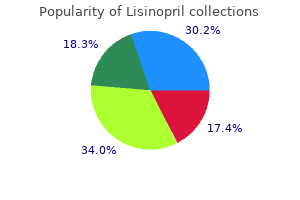
People who smoke are exposed to free radicals inhaled in the tobacco smoke and have an increased risk of many diseases blood pressure bulb replacement lisinopril 5mg discount. People abusing alcohol need to develop increased metabolic capacity to handle the extra alcohol load prehypertension and alcohol order lisinopril 10mg mastercard. Similar risks may be faced by people working in environments where there are elevated levels of volatile solvents arteria genus media order lisinopril 10mg with amex. Car drivers and other people working in dense traffic may be exposed to elevated 280 Chapter 17: Dietary antioxidants levels of exhaust fumes blood pressure average calculator cheap 5 mg lisinopril overnight delivery. Of the above groups, smokers are the most widely accessible people and this has made them a target for several large antioxidant-nutrient intervention studies. In addition, smokers often display low plasma concentrations of carotenoids and vitamin C. However, no obvious benefits to the health of smokers have emerged from these studies and, in fact, -carotene supplements were associated with an increased risk of lung cancer in two separate studies (35, 94) and with more fatal cardiac events in one of them (95). Other risk groups identified by their already having had some non-malignant form of cancer, such as non-melanomatous skin cancer (77) or a colorectal adenoma (96), showed no effect on subsequent recurrences after several years of elevated intakes of antioxidant nutrients. The use of -carotene (77) or vitamin E alone or in combination with vitamin C (96) showed no benefits. Thus, the results of these clinical trials do not support the use of supplementation with antioxidant micronutrients as a means of reducing cancer or even cardiovascular rates although in the general population, toxicity from such supplements is very unlikely. Some intervention trials however have been more successful in demonstrating a health benefit. Stitch and colleagues (97, 98) gave large quantities of -carotene and sometimes vitamin A to chewers of betel quids in Kerala, India, and to Canadian Inuits with premalignant lesions of the oral tract and showed reductions in leukoplakia and micronuclei from the buccal mucosa. These studies are difficult to interpret because the subjects may have been marginally malnourished at the start and the supplements may have merely restored nutritional adequacy. The mean age of this group was 63 years and obviously they were not a normal adult population, but results of further studies are awaited with keen interest. Lastly, results of the Cambridge Heart Antioxidant Study should be mentioned because they provide some support for a beneficial effect of vitamin E in persons who have had a myocardial infarction (100). Recruits to the study were randomly assigned to receive vitamin E (800 or 400 mg/day) or placebo. Initial results of the trial suggested a significant reduction in nonfatal myocardial infarctions but a non-significant excess of cardiovascular deaths (100). The trial officially ended in 1996, but mortality has continued to be monitored and the authors now report significantly fewer deaths in those who received vitamin E for the full trial (101) (see Chapter 9). In conclusion, some studies have shown that health benefits can be obtained by some people with increased risk of disease from supplements of antioxidant nutrients. The amounts of supplements used have, however, been large and the effect possibly has been pharmacologic. Further work is needed to show whether more modest increases in nutrient intakes in healthy adult populations will delay or prevent the onset of chronic disease. The evidence available regarding health benefits to be achieved by increasing intakes of antioxidant nutrients does not assist in setting nutrient requirements. Proposed definition and plan for review of dietary antioxidant and related compounds. Dietary carcinogens and anticarcinogens, oxygen radicals and degenerative diseases. Update on the biological characteristics of the antioxidant micronutrients: vitamin C, vitamin E and the carotenoids. Dietary antioxdant flavonoids and risk of coronary heart disease: the Zutphen Elderly Study. Copper and iron are mobilised following myocardial ischemia: Possible predictive criteria for tissue injury. Kinetics of nitric oxide and hydrogen peroxide production and formation of peroxynitrite during the respirtory burst of Human neutrophils. Direct observations of a free radical interaction between vitamin E and vitamin C.
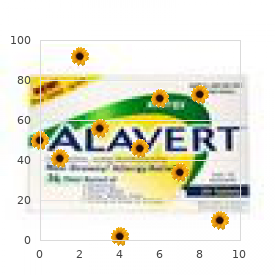
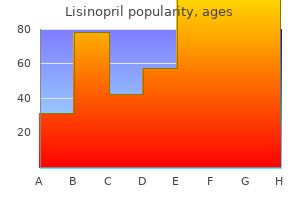
To determine the most appropriate mix blood pressure wrist cuff discount 10 mg lisinopril mastercard, a situation analysis should first be conducted on the magnitude blood pressure chart vaughns 1 pagers com order lisinopril 5mg with amex, prevalence arteria zarzad lisinopril 2.5mg free shipping, and distribution of deficiencies blood pressure medication drowsiness order lisinopril 10 mg on line, food consumption levels including the intake of micronutrients, and food habits and attitudes of vulnerable groups, including socioeconomic data to identify major constraints and opportunities. The most successful approach to increasing consumption of micronutrient rich foods is likely to be a combined strategy that addresses both increased production (supply) and increased consumption (demand) of food. The special needs of particular groups such as children and women of childbearing age require particular attention. Food-based intervention programs, dietary enhancement and diversification, and food fortification including biofortification play a critical role in alleviating micronutrient malnutrition. Food-based strategies focus on improving the availability of, access to , and consumption of vitamin and mineral rich foods. Benefits of such food-based strategies include not only improved intakes of specific nutrients but also improved overall diets and health status. Government policies and regulations can influence the availability and price of micronutrient rich foods. Vitamin and mineral deficiencies can be reduced with relatively small investments in agriculture, education, and public health. National agricultural planning strategies such as crop diversification to promote micronutrient rich crops, agroforestry, and the promotion of traditional and wild foods can have an impact on the availability of micronutrient foods. Regulations that prohibit urban gardening or which reduce the availability or sale of fresh foods by street vendors can reduce the availability of micronutrient foods. Examining the profitability of producing, processing, and marketing such foods and reviewing the impact of policies on micronutrient status are important steps in planning food-based strategies. Policies, intervention programs and activities at the international, national, and community level are required to effectively alleviate micronutrient deficiencies. These efforts include: 1) Increasing the overall quantity of foods consumed by those most vulnerable to deficiencies and at the same time 2) Diversifying their diets with focus on micronutrient rich sources of food including animal products, vitamin C, fruit and vegetables; 3) Better managing and controlling dietary inhibitors. Strategies to promote dietary diversification within the implementation of food-based approaches include: 1. Increasing overall food intakes Micronutrient deficiencies are closely associated with poverty, food insecurity, and undernutrition and are common in those groups whose overall food intakes are not sufficient to meet nutritional requirements. For those with inadequate food intakes, increasing overall food consumption provides several essential micronutrients thereby simultaneously addressing a combination of deficiency problems. Consequently, intervention programs need to as a first priority to ensure that overall food supplies are adequate through increasing the production, availability, access to , and consumption of an adequate and nutritious diet, especially by those who are hungry and food insecure and most vulnerable to deficiencies. By doing so, food-based strategies address the root causes of micronutrient malnutrition and assist communities and households to adequately feed and nourish themselves in both the short and long term. Stimulating the small scale agricultural sector can produce overall long-term economic benefits for those groups dependent upon agriculture for their livelihoods and for the economy as a whole, thereby encouraging sustainable development. The promotion of dietary improvement/diversification with a focus on improving the intake of bioavailable iron through greater consumption of animal products, fruit and vegetables, especially those rich in vitamin C, is the only intervention that can lead to self-sustained success in improving iron status. Promoting consumption of micronutrient rich foods fosters better overall health for all members of society, provides sustainable improvements by encouraging market solutions and long-term behavioral changes among high risk groups and is often linked to income earning activities. Efforts to address both increased production (supply) and increased consumption (demand) of food need to be undertaken simultaneously. At the district and national levels, implementation of large scale commercial livestock and vegetable and fruit production can provide micronutrient foods at reasonable prices. The objective is to provide micronutrient rich foods at reasonable prices through effective and competitive markets and distribution channels which can lower consumer prices without reducing producer prices. Commercial oil seed production and red palm oil for example can increase the availability of low cost dietary fat crucial for the absorption of fat soluble vitamins (A, D, E and K) and of other micronutrients, including iron. At the community level, small-scale community or home fruit and vegetable gardens can play a significant role in increasing production of micronutrient rich foods. Production of fish, poultry and small animals such as guinea pigs, rabbits, and goats are excellent sources of highly bioavailable essential micronutrients such as vitamin A, iron, and zinc. Increasing consumption of micronutrient rich foods Most traditional diets and food habits provide a range of nutrients that are able to meet the nutritional requirements of most groups. However, those physiologically challenged such as the sick, young children, and pregnant and lactating women may require larger amounts of micronutrient rich foods to meet their increased needs.
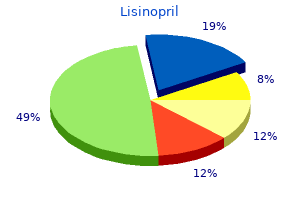
Also blood pressure medication weight loss safe lisinopril 10 mg, information about the sensitivity of rapid diagnostic tests for the 2 less common species of malaria blood pressure guidelines by age lisinopril 2.5mg, P ovale and P malariae blood pressure upper limits purchase lisinopril 5mg on-line, is limited heart attack kush lisinopril 5mg for sale. Effective measures to reduce the risk of acquiring malaria include control of Anopheles mosquito populations, protection against mosquito bites, treatment of infected people, and chemoprophylaxis of travelers to areas with endemic infection. The appropriate chemoprophylactic regimen is determined by the local prevalence of drug resistance. Drugs used for malaria chemoprophylaxis generally are well tolerated, although adverse reactions can occur. Travelers with serious adverse reactions should be advised to contact their physician. Chemoprophylaxis should begin before arrival in the area with endemic malaria 1 Centers for Disease Control and Prevention. Notice to readers: new medication for severe malaria available under an investigational new drug protocol. If there is desire to ensure tolerance of the antimalarial drug to be used for prophylaxis, then the drug should be started earlier so that there is time to assess any adverse events before departure and time to change to another effective drug if needed. For example, if there is concern about indi- Drugs for the prevention of malaria currently available in the United States include Chloroquine is an option for people traveling to parts of the world where chloroquine resistance has not developed. Adverse reactions that can occur include gastrointestinal tract disturbance, headache, dizziness, blurred vision, insomnia, and pruritus, but these generally are mild and do not require discontinuation of the drug. Atovaquone-proguanil is taken daily, starting 1 day before exposure and continuing for the duration of exposure and for 1 week after departure from the area with endemic malaria. A pediatric formulation is available in the United States but is not approved for prophylaxis in children weighing less than 11 kg. The rare adverse effects reported by people using atovaquoneproguanil for chemoprophylaxis are abdominal pain, nausea, vomiting, mouth ulcers, and headache. Doxycycline is taken daily, starting 1 to 2 days before exposure, for the duration of exposure and for 4 weeks after departure from the area with endemic malaria. Travelers taking doxycycline should be advised of the need for strict adherence to daily dosing; the advisability of always taking the drug on a full stomach; and the possible adverse effects, including diarrhea, photosensitivity, and increased risk of monilial vaginitis. Use of doxycycline should be avoided for pregnant women and for children younger than weekly during travel, and for 4 weeks after travel has concluded (see Drugs for Parasitic considered for use in children, regardless of weight or age restrictions, when travel cannot be avoided to areas where chloroquine-resistant P falciparum exists. Parents should be advised not to travel to countries with endemic malaria with children weighing less than 5 kg or younger than 6 weeks because of the risks associated with infection (septicemia or malaria) in young infants. The most common central nervous system abnormalities seizures) at prophylactic doses. Although the product labeling contains a warning about concurrent by people concurrently receiving beta-blockers if they have no underlying arrhythmia. Malaria may increase the risk of adverse outcomes in pregnancy, including abortion, preterm birth, and stillbirth. For these reasons and because no chemoprophylactic regimen is absolutely effective, women who are pregnant or likely to become pregnant should try to avoid travel to P falciparum has not been reported may take chloroquine prophylaxis. Harmful effects on the fetus have not been demonstrated when chloroquine is given in the recommended doses for malaria prophylaxis. Pregnancy and lactation, therefore, are not contraindications for malaria prophylaxis with chloroquine. For pregnant women who travel to areas where chloroquine-resistant P falciparum who are pregnant or likely to become pregnant when exposure to chloroquine-resistant P falciparum is unavoidable. Lactating mothers of infants weighing more than 5 kg chloroquine-resistant P falciparum is unavoidable. Travelers to malaria-endemic settings should seek medical attention immediately if they develop fever. Malaria can be treated with good results if begun early in the course of disease, but delay of appropriate treatment can have serious or even fatal consequences. Travelers who do not take an antimalarial drug for prophylaxis, who are on a less-than-effective regimen, or who may be in very remote areas can be given a reliable supply of atovaquone-proguanil or artemether-lumefantrine. If they are diagnosed with malaria while traveling, they will have a medicine that will not interact with their other medications, is of good quality, and is not depleting local resources. Travelers taking atovaquone-proguanil as their chemoprophylactic drug regimen should not take atovaquone-proguanil for treatment and should use an alternative antimalarial regimen recommended by a travel medicine expert.
